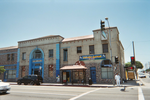LAPD Hooper Heliport
AC with 0 elementsAirports in Los Angeles County, CaliforniaHeliports in the United StatesLaw enforcement stubsLos Angeles Police Department ... and 1 more
Police aviation

LAPD Hooper Heliport (FAA LID: 58CA) is a city-owned private-use heliport located one nautical mile (2 km) northeast of the central business district of Los Angeles, in Los Angeles County, California, United States.
Excerpt from the Wikipedia article LAPD Hooper Heliport (License: CC BY-SA 3.0, Authors, Images).LAPD Hooper Heliport
East Cesar E Chavez Avenue, Los Angeles Downtown
Geographical coordinates (GPS) Address Nearby Places Show on map
Geographical coordinates (GPS)
| Latitude | Longitude |
|---|---|
| N 34.05438 ° | E -118.22953 ° |
Address
C. Erwin Piper Technical Center
East Cesar E Chavez Avenue
90086 Los Angeles, Downtown
California, United States
Open on Google Maps








